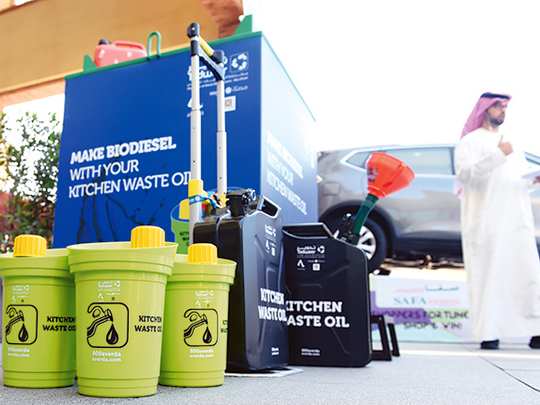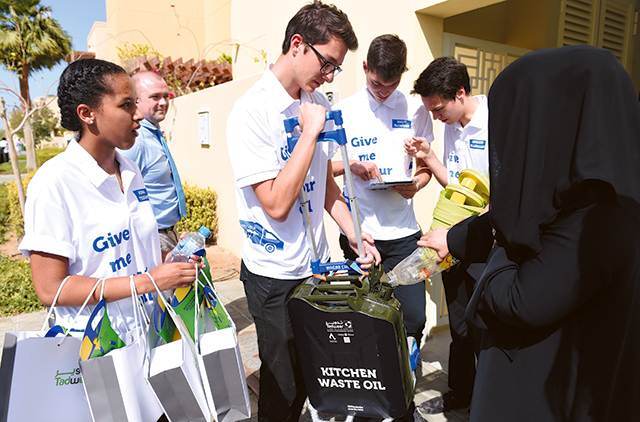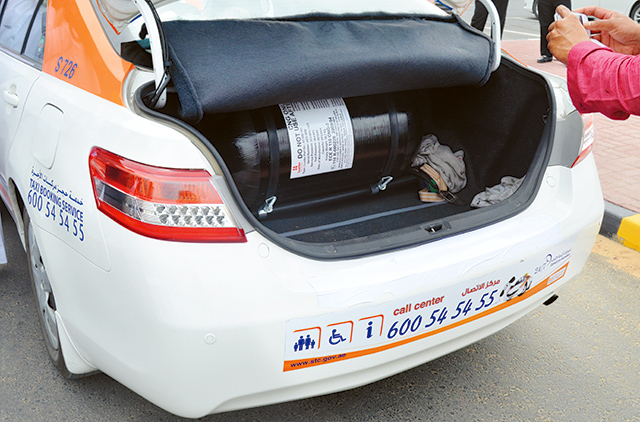
Why flush it down the kitchen sink when you could instead use it to power vehicles? In a pilot project last month, residents of the Al Raha area in Abu Dhabi were given bright green cans by Tadweer, a waste management company, to collect used cooking oil. These were later centrally collected at a neighbourhood dump, from where the waste was whisked away for recycling and treatment at a reactor developed indigenously by the Masdar Institute.
The end result? Biodiesel for vehicles.
This initiative is also a clever two-birds-with-one-stone solution, says Eisa Saif Al Qubaisi, Tadweer’s general manager. He tells Gulf News that the project was initially launched due to issues cooking oil was causing in the sewage network.
Another innovative two-in-one idea is the two-hectare farm at Masdar City, where seawater and organic waste will be used to grow halophytes and generate biofuels. The project, which went live this month, will also nurture shrimp and fish.
Elsewhere in the UAE, McDonald’s has been running its entire transport fleet on biodiesel, clocking five million kilometres as of November. Dubai Municipality is also on board — in February last year, it signed an agreement with Neutral Fuels to replace diesel in its vehicles with biodiesel. Neutral Fuels claims this makes Dubai the first city in the world to formally adopt biodiesel entirely made locally from waste cooking oil for use in municipal vehicles.
These may be relatively small initiatives, but they point to a future where the UAE will increasingly veer away from fossil fuels and favour alternative fuels for everything from desalination to transport.
This will also help meet a declared goal in the UAE National Strategy 2021: to reduce CO2 emissions by 15 per cent. In a January trend analysis, BMI Research highlighted the Dubai RTA’s plan to test electric buses. The need for such projects in the GCC was underlined by a 2010 report by the International Energy Agency, which showed Qatar had the highest level of CO2 emissions per capita in the world, with 36.9 tonnes. The UAE was 20.5 tonnes, while the average for the Middle East was 7.56 tonnes.
The report said public transport is the best means for increasing public exposure to alternative fuels, and the GCC offers considerable growth potential for such fuels.
The many types of alternative fuels
The world of alternative fuels is filled with innovative ideas and sometimes tall claims — powering vehicles with water, for example.
However, a few categories have emerged stronger and stand a better chance at becoming the fuels of the future. Especially biodiesel.
ConsumerReports calls it “a promising blend” that is renewable, easily available, requires no modification to diesel vehicles, and can often be sourced for free. On the flip side, the agency notes the conversion process is expensive, quality of biodiesel varies and supply issues have prevented it from becoming widespread.
But there are other options. One, ethanol, is low emission, high-octane and can be produced from waste. But it has a low fuel economy and when made from food crops, can adversely affect the prices of staple foods. Ironically, the equipment used in its generation runs on fossil fuels, negating its green benefits.
Another is compressed natural gas (CNG). CNG is cheap and more efficient than gasoline. However, the tank takes up valuable trunk space and refuelling stations are currently few and far apart.
Meanwhile, an alternative that has captured popular imagination is the hydrogen fuel cell. The technology promises zero emissions — the only residue here is pure water. ConsumerReports observes the fuel economy is double that of gasoline, hydrogen is abundant and can be made from renewable energy. However, it is expensive and “acceptable range requires extremely high-pressure, on-board hydrogen storage”. Besides, a robust delivery infrastructure is still not in place.
In the car segment, electric vehicles have gained traction, but the sheer size of the batteries required on heavier commercial vehicles makes them impractical. Navigant Research says their appeal will be limited to urban fleets with low daily mileage. It projects the global penetration of electric-drive trucks and buses will have grown from 0.4 per cent in 2014 to 2.9 per cent by 2023.
Which fuel to switch to?
For many businesses, operating a fleet is the largest contributor to their carbon footprint and any decision to reduce emissions requires fleet managers to identify which alternative fuel will make the biggest difference. According to Ford’s Alternative Fuel Buyer’s Guide, the overarching goal is to achieve and maintain the lowest total cost of ownership (TCO) for the fleet. The company advises examining the combination of acquisition costs, duty cycle, mileage travelled, fuel prices, associated infrastructure, maintenance costs and the residual value of the vehicles to determine the TCO.
“Although acquisition costs for alternative fuel vehicles may be higher, these costs are often offset by lower costs of alternative fuels. In addition, the lower volatility of alternative fuel prices reduces risk of future price shocks,” adds the guide, while laying out general rules of thumb — the higher the annual miles driven, the more likely alternative fuels will make economic sense. The lower the fuel efficiency, the more that alternative fuels will make economic sense.
Finally, the wider the price gap between an alternative fuel and gasoline, the shorter the payback period.














